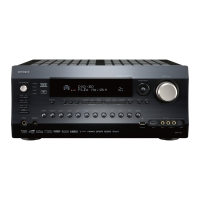165
Troubleshooting—Continued
About DTS signals
• When DTS program material ends and the DTS bit-
stream stops, the AV receiver remains in DTS listen-
ing mode and the DTS indicator remains on. This is to
prevent noise when you use the pause, fast forward, or
fast reverse function on your player. If you switch your
player from DTS to PCM, because the AV receiver
does not switch formats immediately, you may not
hear any sound, in which case you should stop your
player for about three seconds, and then resume play-
back.
• With some CD and LD players, you won’t be able to
playback DTS material properly even though your
player is connected to a digital input on the AV
receiver. This is usually because the DTS bitstream
has been processed (e.g., output level, sampling rate,
or frequency response changed) and the AV receiver
doesn’t recognize it as a genuine DTS signal. In such
cases, you may hear noise.
• When playing DTS program material, using the pause,
fast forward, or fast reverse function on your player
may produce a short audible noise. This is not a mal-
function.
The beginning of audio received by an HDMI IN
can’t be heard
• Since it takes longer to identify the format of an
HDMI signal than it does for other digital audio sig-
nals, audio output may not start immediately.
There’s no picture
• Make sure that all video connecting plugs are pushed
in all the way (page 26).
• Make sure that each video component is properly con-
nected (pages 28 to 43).
• If your TV is connected to the HDMI output, set the
“Monitor Out” setting other than “Analog” (page 49),
and select “- - - - -” in the “HDMI Input Setup” on
page 51 to watch composite video, S-Video, and com-
ponent video sources.
• If your TV is connected to the COMPONENT VIDEO
MONITOR OUT, S MONITOR OUT, or V MONI-
TOR OUT, set the “Monitor Out” setting to “Analog”
(page 49), and select “- - - - -” in the “Component
Video Input Setup” on page 52 to watch composite
video and S-Video sources.
• If the video source is connected to a component video
input, you must assign that input to an input selector
(page 52), and your TV must be connected to either
the HDMI OUT or COMPONENT VIDEO MONI-
TOR OUT (pages 28 and 32).
• If the video source is connected to an HDMI input,
you must assign that input to an input selector
(page 51), and your TV must be connected to the
HDMI outputs (page 28).
• On your TV, make sure that the video input to which
the AV receiver is connected is selected.
• If you selected “Both (Main)” or “Both (Sub)” in the
“Monitor Out” setting, no picture may appear on your
TV that is connected to a secondary HDMI output (not
a priority HDMI output). In this case, change the set-
ting to “Both” (page 49).
There’s no picture from a source connected to
an HDMI IN
• Reliable operation with an HDMI-to-DVI adapter is
not guaranteed. In addition, video signals from a PC
are not guaranteed (page 28).
• When the “Monitor Out” setting is set to “Analog”,
and the “Resolution” setting is set to anything other
than “Through” (page 50), no video is output by the
HDMI outputs.
• When the “Resolution” (page 50) is set to any resolu-
tion not supported by the TV, no video is output by the
HDMI outputs.
• If the message “Resolution Error” appears on the AV
receiver’s display, this indicates that your TV does not
support the current video resolution and you need to
select another resolution on your DVD player.
The onscreen menus don’t appear
• If your TV is connected to the analog outputs, set the
“Monitor Out” setting to “Analog” (page 49).
• (Australian models) Specify the TV system used in
your area in the “TV Format Setup” on page 56.
• On your TV, make sure that the video input to which
the AV receiver is connected is selected.
The picture is distorted
• (Australian models) Specify the TV system used in
your area in the “TV Format Setup” on page 56.
The immediate display does not appear
• If you select other than “Analog” in the “Monitor Out”
setting (page 49), the immediate display will not
appear when the input signal from the COMPONENT
VIDEO IN is output to a device connected to the
COMPONENT VIDEO MONITOR OUT.
• Depending on the input signal, the immediate display
may not appear when the input signal from the HDMI
input is output to a device connected to the HDMI out-
put.
Reception is noisy, FM stereo reception is
noisy, or the FM STEREO indicator doesn’t
appear
• Relocate your antenna.
• Move the AV receiver away from your TV or com-
puter.
• Listen to the station in mono (page 69).
• When listening to an AM station, operating the remote
controller may cause noise.
• Passing cars and airplanes can cause interference.
Video
Tuner

